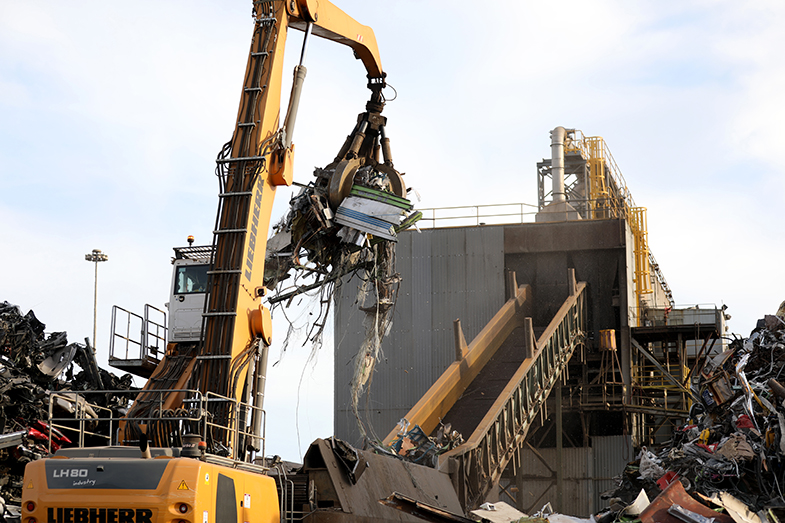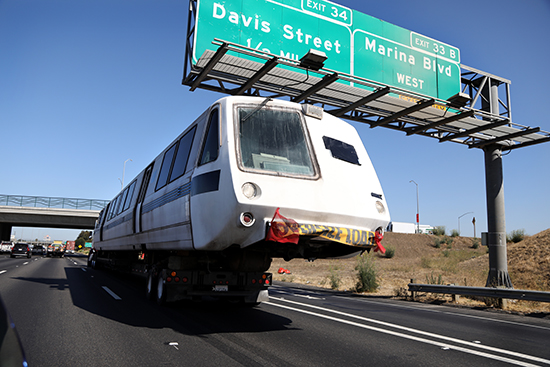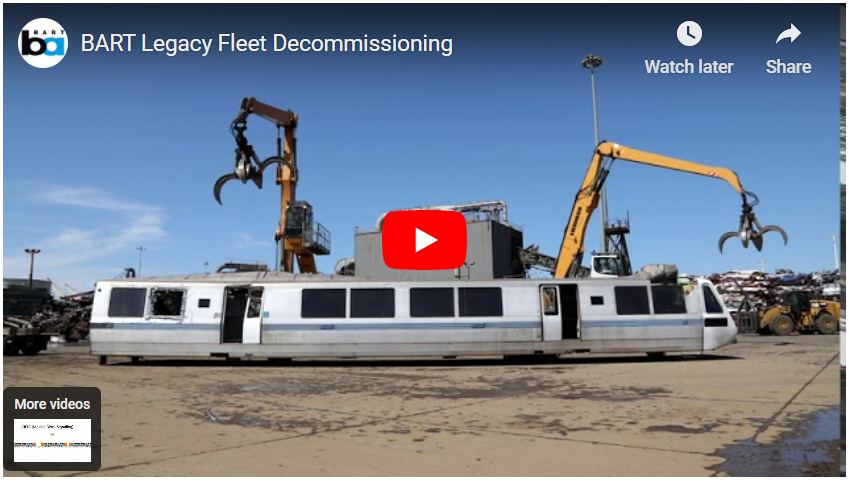Legacy Fleet Decommissioning
As BART’s legacy cars have a tremendous sentimental value with passengers in the greater San Francisco Bay Area, BART offered the public an oppurtunity to submit proposals to give these cars a second life.
On January 19th, 2021, BART launched the official call for proposals through the release of a Pre-Qualification Application Process. The deadline for Pre-Qualification Applications was March 12, 2021 at 5pm PST.
The call for proposals is now closed.
20 individuals and organizations submitted proposals. BART is not naming the proposers until final selections are made near the end of the year (2021), due to their ongoing status in the evaluation process. They run the gamut from museums, restaurants, first-responder organizations who would use them for training, parks and recreation, a sports team, design students, community organizations and private individuals who want to turn them into livable spaces. Read our update.
Program Schedule:
- Release of Pre-Qualification Application - January 19, 2021
- Due Date for Pre-Qualification Application - March 12, 2021 (5pm PST)
- Notification of Successful Applicants/Issuance of RFP - June 18, 2021
- Question & Answer period- June 21-August 31, 2021
- Deadline for RFP- September 17, 2021
- Award of Proposals- December 2021
- Proof of Concept period- January-June 30, 2022 (or as negotiated)
View and download our Pre-Qualification for Proposals Brochure about the proposal process, timeline and car measurements.
A project selection committee will review applications and make selections based on proposals meeting all the required criteria, including a plan for their final disposition after the project use is done.
Our fleet of legacy train cars, many of which date back to the start of BART in 1972, are being decommissioned and we are giving museums, nonprofits, agencies and the general public a chance to extend the lives of decommissioned train cars in creative and innovative ways.
Email questions to the project team at [email protected].
It is important to us that the future of these cars continue to be a great representation of BART and that their use is appropriate. We’ve developed these guidelines for anyone interested in purchasing the cars.
Vehicle Acquisition Guidelines
Image and heritage
Proposal must have a positive impact on BART’s brand and must not bring reproach upon the District or other entities or persons.
Environment and sustainability
Proposal must have minimal impact on the environment, meet local ordinances, codes and required reviews and permitting and must include a plan for the final disposal of the vehicle.
Quality of concept
Proposal must be fully detailed with objectives and the target market/audience clearly identified; the project must be both feasible and achievable.
Guarantee of project delivery
Proposal must reflect the bidder’s clear understanding of all parameters, solid framework for the project, as well as financial and technical ability to carry out the project.
Timing and logistics
Proposal’s time frame and deployment must take into consideration the availability of the decommissioned cars.
Ultimate Disposal
Proposal must include how the vehicles will be ultimately disposed of, upon end of life.
Community Benefits
Special consideration will be provided to proposals that include community benefits, and/or creativity of reuse, and/or alignment to the celebration of transit.
Cost Considerations
Projects must be cost-neutral to BART and relieve BART of future liability. A peer review of other agencies show all costs are covered by the purchaser.
Costs include
- Transportation fees (rental of truck and mileage to final destination)
- BART labor cost of prepping car and loading onto the truck
- Cost of offloading car from flat bed and final positioning (large crane required)
- Insurance (depends on ultimate use of vehicle)
- Estimated to run about $8,000-$10,000 per car
Decommissioning Process
The decommissioning is a complex process because BART will operate a mixed fleet of new and old cars for several years. The new and old cars can't join together in one train, but there will be full train sets made up of new and old cars running simultaneously. This will require balancing the operational need to expand service and lengthen trains, the Fleet of the Future delivery schedule, managing storage for all the train cars and deciding how and when to retire the legacy cars.
BART’s legacy fleet is composed of 59 A2 cars and 380 B2 cars (from the ‘70s; rehabbed in 1998 and 2002 and eligible for retirement in 2018 and 2022); 150 C1 cars (from the ‘80s, never rehabilitated, eligible for retirement in 2015 and 2018); and the generally worst-performing cars, 80 C2 cars (from the ‘90s, never rehabilitated, eligible for retirement in 2018 and 2021).
The car selection criteria for decommissioning will take into consideration the following, at a minimum:
- Reliability – Mean Time Between Incident (MTBI) and MTBI rate/1000 hours over a 12- and 24-month period. Decommission “repeaters” or bad actors that impact service reliability
- Availability – Long term holds due to accident damage
- Exterior and interior condition
- Hours (total number of service hours the car has run)
- Time remaining on key components
- Status of component overhauls
- APSE (Auxiliary Power Supply Equipment) type
The majority of the old cars will be recycled. The Fleet Disposition Team will manage the process, including selecting which parts should be harvested from retired vehicles and choosing which cars with the highest failure rates get retired first. BART removes serviceable components such traction motors, axles, wheels, HVAC units, etc. that can still be used to maintain the existing fleet. This cost saving effort allows for serviceable components to be stored as spares, for use on the remaining legacy fleet. Hazardous materials are properly disposed of at the BART shop before the train car is sent to the scrap yard.
When the car has been completely picked over, typically, giant eye bolts are used to elevate the 60,000-pound car in the shop and carefully guide it onto the back of a low flatbed truck.
At the recycle facility, a huge machine crushes the car and breaks it into chunks.
Workers put the big chunks through a series of steps that sort out the different types of metal materials – mostly steel, aluminum and copper – and run them through a mega-shredder that can pulverize them into tinier pieces. It’s a finely tuned process that ends up sending metal materials, on either bulk cargo vessels or container ships, to mills and foundries around the world, to get new life when used in other products that, for example, support critical infrastructure and transportation projects.
One train car can yield up to 22 tons of metal – around 15 tons of steel, 6 tons of aluminum and 1 ton of copper. According to the Institute for Scrap Recycling Industries, recycling just 1 ton of steel conserves 2,500 pounds of iron ore, 1,400 pounds of coal and 120 pounds of limestone. And, creating products from recycled steel instead of virgin ore uses 70% less energy and 40% less water and reduces mining wastes by 97%.

Some ideas that have caught the public’s eye in other places aren’t a good fit for the BART fleet. As an example, some carbon steel subway cars from other systems have been sunk into the ocean for use as part of an artificial reef, but the aluminum composition of BART cars prevents this from being feasible. Some agencies can sell off their train cars to be reused by other systems; BART, however, operates on a non-standard gauge or track width that wouldn’t work in most places.
View the September 10, 2020 Board of Directors presentation.
View the Jan. 10, 2019 Board of Directors presentation.
Email the project at [email protected]
Watch our video of the decommissioning and recycling process:



